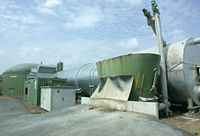
Photo from wikipedia
Abstract The challenge of sustainable cities involves rethinking some infrastructure systems and supply chains, including those for energy and waste. In this sense, the injection of green gas as biomethane… Click to show full abstract
Abstract The challenge of sustainable cities involves rethinking some infrastructure systems and supply chains, including those for energy and waste. In this sense, the injection of green gas as biomethane into the natural gas network could contribute to the reduction of waste in landfills and to the decarbonisation of energy systems. Positive and negative aspects of this challenge have been identified and quantified in comparison with traditional composting and biogas production for electricity, in order to give guidelines to overcome the obstacles that its use shows nowadays. For this, an integrated analytic hierarchy process – strengths, weaknesses, opportunities and threats (AHP-SWOT) analysis, supported by a panel of experts, has been applied. Results have shown the strength derived from the environmental and economic benefits obtained from the by-products, as well as the opportunity of biogas for electricity and biomethane production to generate positive effects on climate change, although the investment and exploitation costs could threaten its implementation. It has been possible to conclude that the use of biomethane in gas networks shows a greater flexibility of use and avoided emissions, so it can become an alternative. Nevertheless, its implementation needs promotion from governments as well as a regulatory framework to support it.
Journal Title: Sustainable Cities and Society
Year Published: 2020
Link to full text (if available)
Share on Social Media: Sign Up to like & get
recommendations!